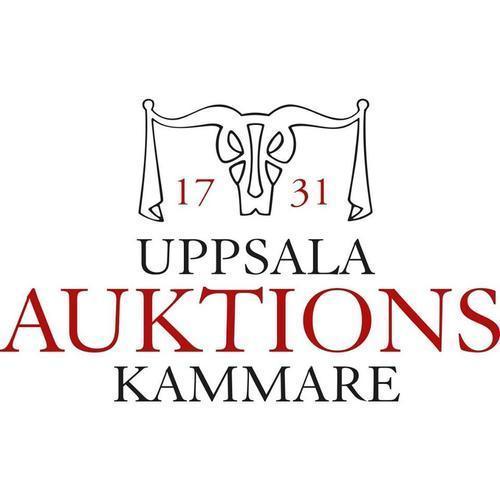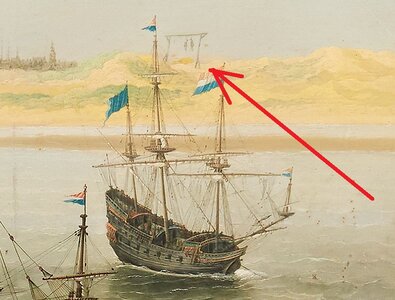In summer this year, a previously unknown but very beautiful painting by Cornelis Verbeeck (1590 - 1637) was sold at a Swedish auction. It is dated to 1625-1630. Larger works by him are rare, so I don't want to withhold this link here. The resolution of the downloadable image is also very pleasing at over 4000px.

 www.uppsalaauktion.se
www.uppsalaauktion.se
From the Description:
This beautifully preserved painting is a hitherto unknown work by the Haarlem marine painter Cornelis Verbeeck of circa 1625/30 and strikes by its precision in rendering the Men o’ war, its light tonality and its larger cabinet size format. Such almost miniature precision of details is characteristic for the artist, whose oeuvre is so far only small. Mostly on small size panels or coppers, there are only two paintings of similar size as the present painting known today. These are the beached ”Men o’ war with a city beyond”, oil on panel, 78.5 x 136 cm, in a Swiss private collection (RKD Explore) and ”the Battle between Spanish and Dutch ships”, oil on canvas, 93 x 137 cm, in the National Maritime Museum, Greenwich, inv. no. BHC0270. Both latter paintings are identically signed as the present painting: CVBH, which is to be understood as Cornelis Verbeeck Haarlem. This signature appears also on the painting of Dutch ships before Saint Helena in the Scheepvaartmuseum, Amsterdam (L.J. Bol, “Die Holländische Marinemalerei des 17. Jahrhunderts”, 1973, p. 51, fig. 51) and the painting of Ships near the coast in the Frans Hals Museum, Haarlem, inv. no. I-608.
Cornelis Verbeeck is no longer a household name among the Dutch painters of the Golden Age. Yet, as explained by J. Giltaij, J. Kelch, Praise of ships and the sea, The Dutch Marine Painters of the 17th Century, Rotterdam, Berlin, 1996/7, p. 137, in his own time he must have held a considerable reputation, since Samuel Ampzing in his “Beschryving ende lof der Stad Haerlem” of 1628 praises him as: “Verbeek is ook heel fraeij en net in schepen – malen” (Verbeek is a high quality painter of ships). Of his life not much is known other then that he was often engaged in rows. With Cornelis Claesz. van Wieringen and Hendrick Cornelisz. Vroom, Verbeeck counts among the early generation of marine specialists in the Northern Netherlands, whose contributions to the development of marine painting consisted of the panorama, in which Southern Netherlandish idioms were combined with the naturalistic tendencies of the North.
Hartmut

Cornelis Verbeeck - Men o’ war outside the coast with a city and a fort beyond - Uppsala Auktionskammare Uppsala Auktionskammare
Cornelis Verbeeck (Holland ca. 1590‑1637). Men o’ war outside the coast with a city and a fort beyond. Säljs vid vår Internationella Kvalitetsauktion 16-18 juni 2020.
 www.uppsalaauktion.se
www.uppsalaauktion.se
From the Description:
This beautifully preserved painting is a hitherto unknown work by the Haarlem marine painter Cornelis Verbeeck of circa 1625/30 and strikes by its precision in rendering the Men o’ war, its light tonality and its larger cabinet size format. Such almost miniature precision of details is characteristic for the artist, whose oeuvre is so far only small. Mostly on small size panels or coppers, there are only two paintings of similar size as the present painting known today. These are the beached ”Men o’ war with a city beyond”, oil on panel, 78.5 x 136 cm, in a Swiss private collection (RKD Explore) and ”the Battle between Spanish and Dutch ships”, oil on canvas, 93 x 137 cm, in the National Maritime Museum, Greenwich, inv. no. BHC0270. Both latter paintings are identically signed as the present painting: CVBH, which is to be understood as Cornelis Verbeeck Haarlem. This signature appears also on the painting of Dutch ships before Saint Helena in the Scheepvaartmuseum, Amsterdam (L.J. Bol, “Die Holländische Marinemalerei des 17. Jahrhunderts”, 1973, p. 51, fig. 51) and the painting of Ships near the coast in the Frans Hals Museum, Haarlem, inv. no. I-608.
Cornelis Verbeeck is no longer a household name among the Dutch painters of the Golden Age. Yet, as explained by J. Giltaij, J. Kelch, Praise of ships and the sea, The Dutch Marine Painters of the 17th Century, Rotterdam, Berlin, 1996/7, p. 137, in his own time he must have held a considerable reputation, since Samuel Ampzing in his “Beschryving ende lof der Stad Haerlem” of 1628 praises him as: “Verbeek is ook heel fraeij en net in schepen – malen” (Verbeek is a high quality painter of ships). Of his life not much is known other then that he was often engaged in rows. With Cornelis Claesz. van Wieringen and Hendrick Cornelisz. Vroom, Verbeeck counts among the early generation of marine specialists in the Northern Netherlands, whose contributions to the development of marine painting consisted of the panorama, in which Southern Netherlandish idioms were combined with the naturalistic tendencies of the North.
Hartmut







